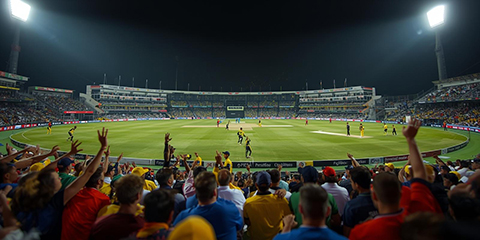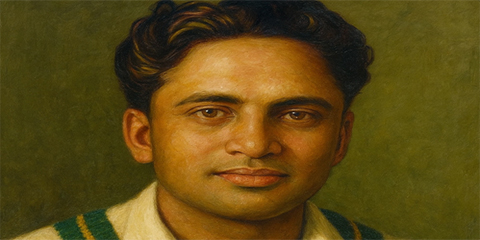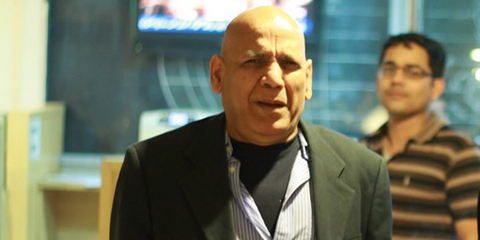What went wrong? Pakistan cricket's strategic failures against India analyzed
JournalismPakistan.com | Published last month | Dr. Nauman Niaz (TI)
Join our WhatsApp channel
ISLAMABAD — Pakistan may yet ascend, may yet lift the chalice of the Asia Cup 2025. Until they are swept aside, routed, and exiled from the tournament, the illusion must not be buried. Let us, for a while longer, cradle our dreams, even if they are no more than phantoms shimmering in the haze. Illusion has, after all, become Pakistan cricket's constant companion, an enchantress to whom board and management alike surrender willingly, drifting in reverie while reality slips, soundless, into shadow. They cling not to fact but to fantasy, not to substance but to the theatre of social media, as if hashtags could substitute for runs, and trending myths for triumphs.
Historical Context: The Shadow of Suspicion
Had this India–Pakistan match, this solemn rite of Asia's cricketing calendar, unfurled in the turbulent 1990s, the air would already be thick with suspicion. Committees would have been convened, inquiries empanelled, commissions summoned, three at least, and perhaps more to question whether Pakistan's innings had been manipulated, contrived, engineered by invisible hands, or choreographed by the secretive puppeteers of chance. I do not, heaven forbid, suggest that such shadows lengthened across yesterday's contest in Dubai. Yet the questions hang like mist over a winter field: searching, unsettling, demanding.
The False Revolution: Babar and Rizwan's Controversial Dismissal
First, the proclamation was issued with the solemnity of reform: Babar Azam and Mohammad Rizwan, the twin custodians of Pakistan's batting, had been deposed. The charge? That their method was antiquated, unfit for the glittering demands of modern cricket. Yet soon the veil was torn, and it was revealed that no true revolution stirred within the hollows of the Pakistan Cricket Board. There was no will to abandon the old instinctive reliance on unstructured skill, no desire to huddle the disciplines of science, of integration, of structure, of process, the only pathway by which Pakistan's cricketers might one day stand eye to eye with the game's great powers.
The Irony of Selection: Statistics Reveal the Absurdity
And so the irony grew pungent. Pakistan, once resplendent in the realm of world cricket, now flounders among the associates, consigned to the game's outer rim. The men chosen to inherit the places of Babar Azam and Mohammad Rizwan? Duller shadows of their predecessors. There is almost splendour in the absurdity of the decision: Babar Azam, with a T20 International strike rate of 129.22, refined further to 132.93 across his last ten matches, his career figure at 129.34, set aside. In his place, Salman Ali Agha was anointed captain, a man whose international strike rate with the bat falters at 111.83, whose last ten innings have produced but 169 runs, his only half-century emerging in Sharjah against Afghanistan at the limp rate of 82.84. And this was to be the symbol of 'new intent,' of a bold narrative rewritten.
The Hassan Nawaz Mystery: Wasted Talent
More bizarre still was the spectacle of yesterday's contest against India. Hassan Nawaz, only recently exalted by management and captain alike as a 'generational player,' a future in flesh and promise, was omitted. His numbers glimmer: an international strike rate of 158.09, an overall rate of 148.06. A specialist opener by craft and instinct, he was shuffled first to number four at Quetta Gladiators, where, despite the exile, he struck with startling effect. Then further still, he was pushed down to number six, a graveyard for a batsman with six-hitting might, his method misplaced though never broken. To drop him now was not a strategy but chaos dressed in authority.
Missed Opportunities: The Bench Strength Ignored
Nor did reason rescue them elsewhere. Mohammad Haris, the wicketkeeper with a career strike rate of 137.73 in internationals and 145.32 in all T20s, never touched bat to ball; his chance never arrived. And Shaheen Shah Afridi, whose bat had twice in recent weeks turned the wreckage of Pakistan's innings into salvation, was passed over in silence. Only days ago, he had conjured 33 not out from 16 deliveries, striking at 206.25 versus India, and against the United Arab Emirates, had struck 29 from 14 at a rate of 207.14. Yet here he was left idle, while pedestrian batsmen, plodding and uninspired, were paraded to their doom.
The Match Begins: Dubai's Deceptive Conditions
The contest began beneath the Dubai lights, that familiar theatre where dew in the second act often rewrites the script. India, having won the toss, elected to chase, an old stratagem, informed by data and drenched with the suspicion that the ball, when sodden by night's breath, loses its sting. The surface wore the customary complexion of Dubai, bare of mystery, yet once the play commenced, the ball carried with unusual life.
The Fakhar Zaman Controversy: Technology and Doubt
Fakhar Zaman and Sahibzada Farhan stitched together an opening embroidery worth 21 in 2.3 overs. Then calamity intruded. Fakhar edged Hardik Pandya to Sanju Samson. It was one of those low, uncertain catches that history seems always to deliver in India–Pakistan matches. The ball caressed the ground, rose like a ghost into Samson's gloves. The celebrations were subdued, a half-believing high-five between Samson and Pandya. Yet technology was summoned, replays lingered in freeze and slow motion. There was doubt in every frame, Samson lunging with his left knee pressed into the turf, the moment ambiguous. But Ruchira Palliyanguruge, the Sri Lankan third umpire, required no second thought. Fakhar was declared out. Pakistan's appeal now travels to the ICC, the PCB sharpening print and parchment for complaint. Yet the futility of the gesture is already foretold: protocols are iron, the match referee, Andy Pycroft, once again in Pakistan's crosshairs after the handshake furore, records dissent in his logbook, decides whether it was fair or unfair, and submits it to the ICC. At most, an umpire suffers a blemish on his annual scroll. The runs Fakhar might have made are already lost to eternity.
The Promising Start and Inevitable Collapse
Saim Ayub followed, carrying the baggage of four zeroes in six innings. But on this night, improbably, there was blossom: Pakistan 55 for one at the end of the powerplay, the partnership climbing to 70 in eight overs, and by the tenth, the score a jubilant 92 for one. A total of 200 or more shimmered within reach. Then Saim departed, and with his dismissal began the unraveling.
Tactical Confusion: The Middle Overs Disaster
Farhan strode beyond his half-century, but the choices around him descended into farce. Hussain Talat was sent at four, a batsman by habit of rotating the strike, not of breaking chains. Here, in the season of momentum, he anchored instead, wasting 11 deliveries, five of them dot. With Farhan, he eked out only 17 in 17 balls. Into this muddle stepped Mohammad Nawaz, ahead of Faheem Ashraf, ahead of Mohammad Haris, ahead even of Shaheen Afridi, men better tailored for urgency. Nawaz consumed 19 deliveries, gifting nine dots, contributing but scraps. His partnership with Sahibzada crawled: 5 runs in 6 balls. Farhan himself was starved of strike, facing only six of 23 balls across two wickets' passage, scoring five. Twenty-two runs in 23 balls: India had seized command.
India's Bowling Mediocrity Exposed Pakistan's Chaos
What made it grotesque was that Bumrah was not in rhythm, Axar Patel was nursing an injury, and Kuldeep Yadav was awry. Yet Pakistan tangled itself against Shivam Dube, a trundler of no terror. For 37 deliveries, from the 10th to the 16th over, not a boundary fell. Thirty-seven balls, three wickets, only 37 runs. Nawaz was run out, awkward and unseemly, despite his wealth of experience. Salman Ali Agha struck one six, but four of his 13 balls were barren. By the end, Talat had left five dots in 11, Saim six in 17, Nawaz nine in 19, Faheem three in eight, and Sahibzada 20 in 45.
India's Clinical Chase: Shaheen's Repeated Mistakes
Late, belatedly, came the surge, 50 in the last four overs, 43 in the final three, 25 in the closing two. The ledger closed at 172. For the casual eye, it was respectable; for the connoisseur, it was decay disguised. India, even while spilling five catches, found Pakistan's middle overs pedestrian. Then their innings began in an orchestral sweep. Shaheen Afridi, chastened by Abhishek Sharma in their prior encounter, inexplicably bowled short again. Sharma, wiser, stood deep, met the ball on the hook, and sent it soaring. Immaturity met calculation. And alongside Shubman Gill, he shaped a partnership of 69 in the powerplay, 105 in ten overs. Pakistan was already in the shadows.
Captaincy Catastrophe: Salman Ali Agha's Tactical Blunders
Salman Ali Agha, captain in name but adrift in mind, made choices that read like parody. Faheem Ashraf, suited to new-ball duties, was withheld until irrelevance. Instead, Saim Ayub, a part-timer, was flung into the cauldron. Three overs in the first seven, all expensive. Abrar Ahmad joined him. Together they leaked 77 in eight overs. The world's 'best white-ball spinner,' Mohammad Nawaz (Mike Hesson's phrase), was never given the ball. Not one delivery. Talat, too, selected for his medium pace, was ignored. Pakistan, in tactics and in spirit, had abandoned the contest.
Post-Match Humiliation: The Aftermath
The humiliation doubled in its aftermath. Salman Ali Agha spoke of satisfaction in Pakistan's performance. Suryakumar Yadav, India's captain, declared there was no rivalry, no contest with Pakistan. The words fell with the finality of a hammer.
Off-Field Drama: PCB's Administrative Blunders
Beyond the boundary, another comedy unfolded. Reports swirled that Sanjog Gupta had dispatched a stern letter to the PCB, citing three infractions. Filming, supposedly forbidden, of the pre-match briefing where Andy Pycroft sat with Wasim Khan. Yet if filming was illegal, why was the PCB's media manager not stopped? Why did Wasim Khan, General Manager ICC, not intervene firmly? Second, Pakistan's defence that ICC's Anti-Corruption Unit head, Colonel Asif, once of PCB had granted permission weakens the charge. Third, sharing mute visuals on social media may count as a breach, but at worst, it invites a warning or mild sanction.
More risible was PCB's charge against Pycroft himself that he breached the spirit of the game by conveying India's refusal to shake hands. The Code of Conduct holds no such clause. If anything, the message came not from India's management but via the Asian Cricket Council's event manager, himself Indian, but under the chairmanship of Mohsin Naqvi, Pakistan's own PCB head. In accusing Pycroft, the PCB only revealed its own muddle. Pycroft, it is said, never apologized. He only regretted the miscommunication. Where Pakistan might have held ICC or even Yadav to account, they squandered their chance.
A Complete System Failure
Thus, the ledger closes: mismanagement, misjudgment, misadvice, or perhaps deliberate misadvice, leaving the PCB diminished in stature before the court of cricket. The match was lost in tactics, the aftermath in diplomacy. What remains is not rivalry, but thespianism of blunders, played out under the indifferent glow of Dubai's floodlights.
Dr. Nauman Niaz is a civil award winner (Tamagha-i-Imtiaz) in Sports Broadcasting & Journalism, and is the sports editor at JournalismPakistan.com. He is a regular cricket correspondent, having covered 54 tours and three ICC World Cups, and having written over 3500 articles. He has authored 15 books and is the official historian of Pakistan Cricket (Fluctuating Fortunes IV Volumes - 2005). His signature show, Game On Hai, has been the highest in ratings and acclaim.

























